
The Gymnotiformes are an order of teleost bony fishes commonly known as Neotropical knifefish or South American knifefish. They have long bodies and swim using undulations of their elongated anal fin. Found almost exclusively in fresh water, these mostly nocturnal fish are capable of producing electric fields to detect prey, for navigation, communication, and, in the case of the electric eel, attack and defense. A few species are familiar to the aquarium trade, such as the black ghost knifefish, the glass knifefish, and the banded knifefish.

Osteoglossiformes is a relatively primitive order of ray-finned fish that contains two sub-orders, the Osteoglossoidei and the Notopteroidei. All of at least 245 living species inhabit freshwater. They are found in South America, Africa, Australia and southern Asia, having first evolved in Gondwana before that continent broke up. In 2008 several new species of marine osteoglossiforms was described from the Danish Eocene Fur Formation dramatically increases the diversity of this group. This implies that the Osteoglossomorpha is not a primary freshwater fish group with the osteoglossiforms having a typical Gondwana distribution.
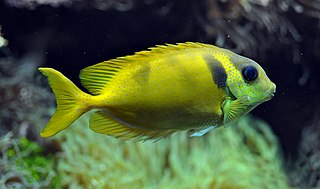
Neopterygii is a subclass of ray-finned fish (Actinopterygii). Neopterygii includes the Holostei and the Teleostei, of which the latter comprise the vast majority of extant fishes, and over half of all living vertebrate species. While living holosteans include only freshwater taxa, teleosts are diverse in both freshwater and marine environments. Many new species of teleosts are scientifically described each year.
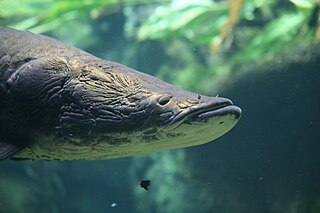
Osteoglossomorpha is a group of bony fish in the Teleostei.
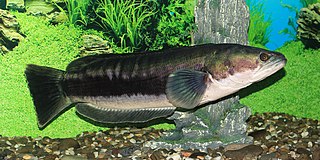
Channa is a genus of predatory fish in the family Channidae, commonly known as snakeheads, native to freshwater habitats in Asia. This genus contains about 50 scientifically described species. The genus has a wide natural distribution extending from Iraq in the west, to Indonesia and China in the east, and parts of Siberia in the Far East. A particularly high richness of species exists in Myanmar (Burma) and northeastern India, and many Channa species live nowhere else. In contrast, a few widespread species have been introduced to several regions outside their natural range, where they often become invasive. The large and medium-sized Channa species are among the most common staple food fish in several Asian countries, and they are extensively cultured. Apart from their importance as a food fish, snakeheads are consumed in some regions as a traditional medicine for wound healing and reducing postoperative pain and discomfort, and collected for the international aquarium pet trade.

Electroreception and electrogenesis are the closely-related biological abilities to perceive electrical stimuli and to generate electric fields. Both are used to locate prey; stronger electric discharges are used in a few groups of fishes to stun prey. The capabilities are found almost exclusively in aquatic or amphibious animals, since water is a much better conductor of electricity than air. In passive electrolocation, objects such as prey are detected by sensing the electric fields they create. In active electrolocation, fish generate a weak electric field and sense the different distortions of that field created by objects that conduct or resist electricity. Active electrolocation is practised by two groups of weakly electric fish, the Gymnotiformes (knifefishes) and the Mormyridae (elephantfishes), and by Gymnarchus niloticus, the African knifefish. An electric fish generates an electric field using an electric organ, modified from muscles in its tail. The field is called weak if it is only enough to detect prey, and strong if it is powerful enough to stun or kill. The field may be in brief pulses, as in the elephantfishes, or a continuous wave, as in the knifefishes. Some strongly electric fish, such as the electric eel, locate prey by generating a weak electric field, and then discharge their electric organs strongly to stun the prey; other strongly electric fish, such as the electric ray, electrolocate passively. The stargazers are unique in being strongly electric but not using electrolocation.

Scleropages is a genus of fish in the family Osteoglossidae found in Asia and Australia. All of these species are carnivorous and have great jumping ability. These species are highly valued as aquarium fish, particularly by those from Asian cultures. In 2003, a study redescribed several naturally occurring color varieties of S. formosus into four separate species. The majority of researchers dispute these redescriptions, arguing that the published data are insufficient to justify recognizing more than one Southeast Asian species of Scleropages and that divergent haplotypes used to distinguish the color strains into isolated species were found within a single color strain, contradicting the findings. They are considered monotypic, consisting of closely related haplotypes based on color. The ancestor of the Australian arowanas: S. jardinii and S. leichardti, diverged from the ancestor of the Asian arowanas about 140 million years ago, during the Early Cretaceous period. The morphological similarity of all seven species shows that little evolutionary change has taken place recently for these ancient fish. The genus had a much wider distribution during the early Cenozoic, with fossil remains known from the Paleocene of Niger and Belgium, and from the Eocene of China.

The Mormyridae, sometimes called "elephantfish", are a superfamily of weakly electric fish in the order Osteoglossiformes native to Africa. It is by far the largest family in the order, with around 200 species. Members of the family can be popular, if challenging, aquarium species. These fish have a large brain size and unusually high intelligence.
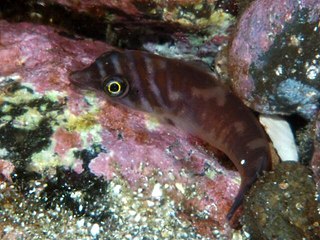
Clingfishes are fishes of the family Gobiesocidae, the only family in the order Gobiesociformes. These fairly small to very small fishes are widespread in tropical and temperate regions, mostly near the coast, but a few species in deeper seas or fresh water. Most species shelter in shallow reefs or seagrass beds, clinging to rocks, algae and seagrass leaves with their sucking disc, a structure on their chest.

Holostei is a group of ray-finned bony fish. It is divided into two major clades, the Halecomorphi, represented by a single living species, the bowfin, as well as the Ginglymodi, the sole living representatives being the gars (Lepisosteidae), represented by seven living species in two genera. The earliest members of the clade appeared during the Early Triassic, over 250 million years ago.

In biology, the electric organ is an organ that an electric fish uses to create an electric field. Electric organs are derived from modified muscle or in some cases nerve tissue, and have evolved at least six times among the elasmobranchs and teleosts. These fish use their electric discharges for navigation, communication, mating, defence, and in strongly electric fish also for the incapacitation of prey.

Marcusenius is a genus of elephantfishes native to Africa. Its members are highly diverse in size, with the smallest species reaching less than 15 cm (6 in) and the largest more than 1 m (3.3 ft).
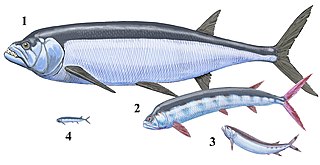
Ichthyodectiformes is an extinct order of marine stem-teleost ray-finned fish. The order is named after the genus Ichthyodectes, established by Edward Drinker Cope in 1870. Ichthyodectiforms are usually considered to be some of the closest relatives of the teleost crown group.

Loaches are fish of the superfamily Cobitoidea. They are freshwater, benthic (bottom-dwelling) fish found in rivers and creeks throughout Eurasia and northern Africa. Loaches are among the most diverse groups of fish; the 1249 known species of Cobitoidea comprise about 107 genera divided among 9 families.

Arapaiminae is a subfamily of freshwater osteoglossiform (bony-tongued) fishes belonging to the family Osteoglossidae. It includes the South American arapaimas of the Amazon and Essequibo basins and the African arowana from the watersheds of the Sahelo-Sudanese region, Senegal, Gambia, and parts of Eastern Africa. This subfamily is sometimes raised to the rank of family, as Arapaimidae. A commonly used synonym is Heterotidinae, but according to the ICZN, Arapaiminae has priority.
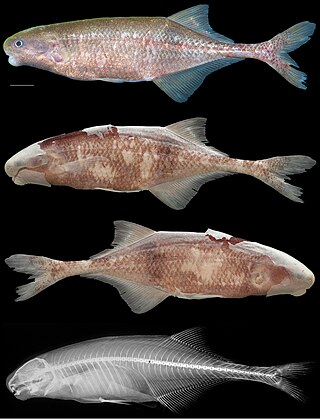
Cryptomyrus is a genus of mormyrid fish native to Gabon.
This list of fossil fishes described in 2017 is a list of new taxa of jawless vertebrates, placoderms, acanthodians, fossil cartilaginous fishes, bony fishes and other fishes of every kind that are scheduled to be described during the year 2017, as well as other significant discoveries and events related to paleontology of fishes that are scheduled to occur in the year 2017. The list only includes taxa at the level of genus or species.
This list of fossil fishes described in 2020 is a list of new taxa of jawless vertebrates, placoderms, acanthodians, fossil cartilaginous fishes, bony fishes, and other fishes of every kind that were described during the year 2020, as well as other significant discoveries and events related to paleoichthyology that occurred in 2020.
This list of fossil fish research presented in 2021 is a list of new taxa of jawless vertebrates, placoderms, acanthodians, fossil cartilaginous fishes, bony fishes, and other fishes that were described during the year, as well as other significant discoveries and events related to paleoichthyology that occurred in 2021.

The Mormyroidea are a superfamily of fresh water fishes endemic to Africa that, together with the families Hiodontidae, Osteoglossidae, Pantodontidae and Notopteridae, represents one of the main groups of living Osteoglossiformes. They stand out for their use of weak electric fields, which they use to orient themselves, reproduce, feed, and communicate.




















